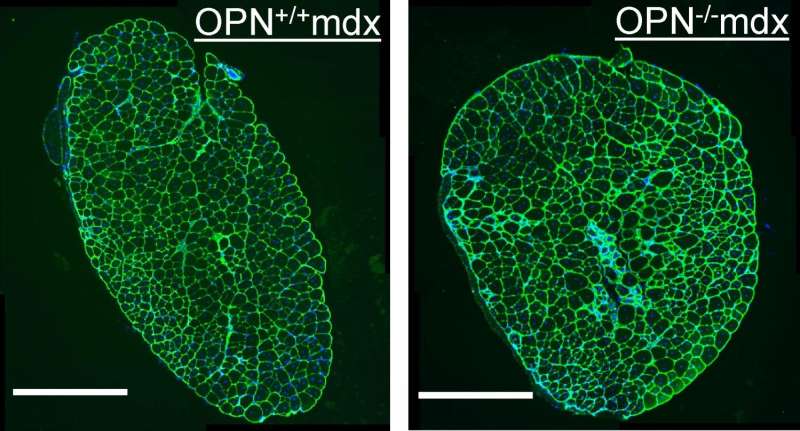Scientists reveal how osteopontin ablation ameliorates muscular dystrophy

Removing an immunomodulatory protein called osteopontin improves the symptoms of mice with muscular dystrophy by changing the type of macrophages acting on damaged muscle tissue, according to a paper published in The Journal of Cell Biology. The study, "Osteopontin ablation ameliorates muscular dystrophy by shifting macrophages to a pro-regenerative phenotype" by Joana Capote and colleagues, adds support to the idea that osteopontin inhibitors could be used to treat patients with Duchenne muscular dystrophy (DMD).
DMD is a progressive, and ultimately fatal, muscle degenerative disease caused by mutations in the gene encoding a protein called dystrophin. These mutations weaken muscle fibers so that they are easily and repeatedly damaged during muscle contraction. Immune cells help to repair this damage, but over time, they can also induce fibrosis, or scarring, which reduces muscle function still further.
Osteopontin is a signaling protein that modulates immune responses and is highly up-regulated in the muscles of DMD patients. A team of researchers led by Melissa Spencer and Irina Kramerova at the David Geffen School of Medicine at UCLA previously demonstrated that removing osteopontin from mdx mice, which have DMD-like symptoms, reduced fibrosis and boosted muscle repair and regeneration. How the loss of osteopontin caused these improvements remained unclear, however, so the researchers now examined the types of immune cell present in mdx mouse muscles in the presence or absence of osteopontin.
The researchers found that removing osteopontin changes the type of macrophage formed in response to muscle damage. In the absence of osteopontin, mdx mouse muscles contained more M2c macrophages, which are thought to stimulate tissue repair, and fewer M1 and M2a macrophages, which are considered to be promoters of inflammation and fibrosis. Accordingly, removing osteopontin caused the macrophages present in mdx mouse muscles to produce multiple pro-regenerative factors, and the muscles themselves grew in both size and strength.
Though osteopontin ablation didn't fully restore the function of mdx mouse muscles, the study suggests that drugs targeting the immunomodulatory protein could be beneficial for DMD patients. "We anticipate that osteopontin inhibitors could be used in combination with other therapeutic agents to slow disease progression and improve muscle function," Spencer says.
More information: Capote, J., et al. 2016. J Cell Biol. dx.doi.org/10.1083/jcb.201510086
















